Dachau Museum 1965 - 2002"We came to the question: How is it with the women and children? I decided to find a clear solution here as well. I did not consider myself justified to exterminate the men - that is, to kill them or have them killed - and allow the avengers of our sons and grandsons in the form of their children to grow up. The difficult decision had to be taken to make this people disappear from the earth." Heinrich Himmler, 6 Oct. 1943, speech at Posen 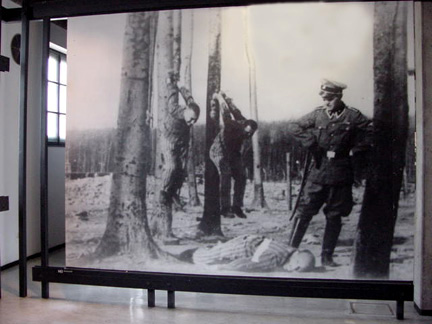 The photograph above shows a huge blowup of a picture that hangs in the Dachau Museum, although it was taken at the Buchenwald concentration camp. As you can see, there is a forest in the background which identifies the surroundings as those of the Buchenwald camp. The photograph shows a cruel and inhuman punishment which the Buchenwald Museum says was devised by the SS guard at Buchenwald who is shown in the picture. Prisoners were hung by their arms from a tree for an hour or more. According to the Dachau Museum, this punishment was also used at the Dachau concentration camp. Prisoners were hung on poles erected in the courtyard between the service building and the bunker. The photograph below shows a display about Heinrich Himmler, the man who started it all. Himmler was the 32-year-old Chief of Police in Munich when he announced on March 20, 1933 that a concentration camp would be opened in the abandoned gun powder and munitions factory in the eastern section of Dachau. What looks like a toupee that doesn't quite cover his bald head is really a popular haircut of that time: the sides and back were shaved with only a section on the top left. His Hitler-style moustache was also popular among the Nazis. This style was adopted after World War I when German men shaved off the ends of their handlebar moustaches after Kaiser Wilhelm II, who wore this popular style, was forced to abdicate. 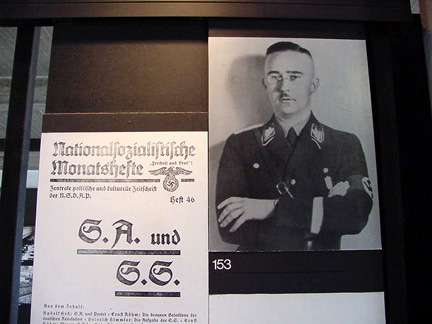 The exhibits in the Dachau Museum are mainly photographs with very few artifacts from the former camp. There is a blue and gray striped uniform and a pair of wooden shoes on display but almost nothing else. In the Dachau Museum, you won't see any glass cases full of hair or open cans of Zyklon B with the gas pellets spilling out. One reason for the almost total lack of artifacts is that the camp was in use, until the late 1950ies, as a refugee camp for 5,000 homeless Germans who were evicted from Poland, Czechoslovakia and eastern Germany after the war. By the time the former concentration camp was turned into a Memorial Site, all the things used by the former inmates were long gone. If you want to see Nazi memorabilia, try the Museum of Tolerance at the Simon Wiesenthal Center in Los Angeles. You won't see any of that here, since all things Nazi were banned in Germany after the war. There is nothing in the Museum about the SS training center and garrison which made up 3/4 of the original Dachau complex. This Museum is all about the victims in the camp, not the perpetrators. A sign in the lobby says that the displays are not appropriate for children under 12 years of age, but this is not a horror museum. Most of the visitors are high school kids. A typical photograph in the museum is the one shown below, which shows a prisoner who was "shot while attempting to escape." 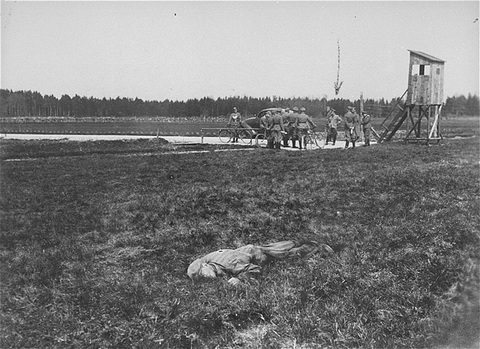 The photograph above, which was taken on May 14, 1941, shows the body of Abraham Borenstein lying in the foreground after he was shot by the SS at Dachau. Two of the SS men pictured are Egon Zill and Franz Johann Hofmann, who participated in the execution. A large group of prisoners can be seen laboring in the fields in the background. After the Russians liberated the Majdanek camp near Lublin, Poland in July 1944, they set up the first concentration camp museum there a month later. This set a precedent for the Allied liberators to use the concentration camps for educational purposes. The Russians were anxious to convert the Poles to Communism by showing them the evils of Fascism. When Dachau was liberated by the Americans, they immediately began educating American soldiers about why they were fighting the Germans. The first museum at Dachau was set up by the American Army in the crematorium building where the gas chambers are located. A sign near the crematorium informed the soldiers that 238,00 persons had been cremated there, more than the number of registered inmates. The soldiers were led to believe that the ashes remaining in the ovens were those of the innocent victims of the Nazis, but they were actually the ashes of the German SS soldiers who were shot with their hands in the air by the American liberators. The ovens had not been used since October 1944 when the US Seventh Army arrived in April 1945. These exhibits remained until 1953, but they educated at least 100,000 soldiers who were brought here to be witnesses to the Nazi atrocities. (One of those witnesses was Chuck Ferree who wrote about Dachau on the day it was liberated.) The photograph below shows the desk that was used to hold the camp records, one of the very few artifacts on display in the Museum. In the background is a large poster which shows the colors of the badges worn by the prisoners. However, most of the the photographs on display show the prisoners wearing uniforms without badges. None of the photographs show Dachau prisoners wearing wooden shoes like the pair that is on display.  The Museum includes a book store which is in front of the movie theater. I was surprised to see many books there which had translations in every language - except English. The theater is quite large, but it fills up fast and there is standing room only by the time the film starts. A 15-minute film is shown every half hour. The English version is shown at 11:30 and 3:30 and the theater is always crowded for these performances. The film includes footage of the Dachau homicidal gas chamber which was shown at the Nuremberg trial. At the end of the film, there is a shot of the original "Arbeit Macht Frei" gate where the prisoners entered the camp. Beyond the door to the movie theater, there is a hallway which leads to the commemorative room that you see in the two photographs below. These photographs show the glass cases on each side of the small room. 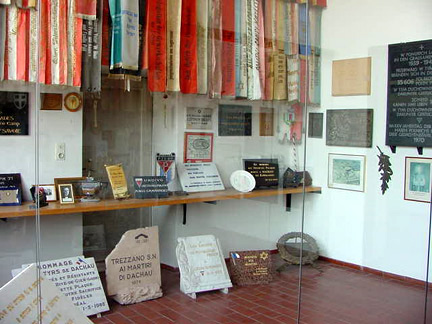 Notice the pick triangle on the right in the photograph below. The inscription at the top reads "Beaten to death, killed again by silence." At the bottom of the plaque, the words read "To the homosexual victims of National Socialism, the homosexual initiatives of Munich, 1985." The homosexuals in the camps received very harsh treatment from their fellow prisoners. In the early days of the Dachau camp, the "kapos," who supervised the other prisoners, were German criminals who were sent to the camp after they finished their prison sentence because they were considered "career criminals." Later the internal administration of the Dachau camp was taken over by the Communist inmates who formed the International Committee. After the war, the homosexuals, asocials and German criminals were not included in the commemoration of the victims. According to the US Holocaust Museum, there were a total of 10,000 homosexuals who were sent to all the concentration camps in Germany for violations of Paragraph 175 in the German penal code. This law had been in place since Germany became a united country in 1871, but had not been enforced. Most of the homosexuals were arrested in Berlin and taken to the nearby Sachsenhausen camp, where there is also a pink triangle in their honor. The pink triangle in the glass case at Dachau was placed here on June 18, 1995. 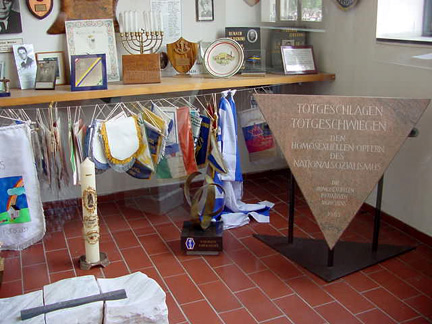 PreviousBack to Table of ContentsBack to Dachau IndexHome |